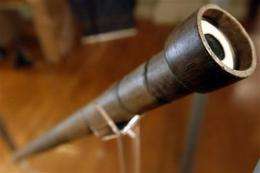Galileo's telescope on historic visit to Philly

(AP) -- Though it looks like a cardboard tube that got left out in the rain, it's a priceless instrument whose owner changed the world. The mottled brown cylinder on display at The Franklin Institute science museum is a 400-year-old telescope used by Galileo Galilei, whose observations of the heavens ultimately changed the face of not only astronomy but all of science.
"Galileo, the Medici and the Age of Astronomy" opens Saturday and runs through Sept. 7. The show makes one other stop, in Stockholm, in time for October's Nobel Prize announcements, before the telescope and other items return in January to their home in the Institute and Museum of the History of Science in Florence.
On display are more than 100 artifacts from that museum, which is closed for extensive restoration work, as well as the Uffizi Gallery and the Pitti Palace in Florence. But the star of the show is the 3-foot-long telescope, a humble-looking wooden tube with Galileo's own handwriting at one end noting the magnifying power of the lens.
It's unknown whether this particular telescope was the one with which Galileo first observed the moon, discovered sunspots and the moons of Jupiter and marked the phases of Venus. But it is one of only two of his telescopes still known to exist.
"This is unique not only because of the items' historical importance, but because it's the only time they will ever be on display outside of Florence," said Institute and Museum of the History of Science director Paolo Galluzzi.
A central theme of the exhibition is the importance of Florence's influential Medici family as advocates of science and art, and how their patronage of Galileo's work have directly shaped the modern world.
The show coincides with the 400th anniversary of Galileo's first astronomical observation - the moon - through a telescope and the designation of 2009 as the International Year of Astronomy by the International Astronomical Union and the United Nations.
A four-day global effort tied to the yearlong celebration, called 100 Hours of Astronomy, also kicked off Thursday and will involve round-the-clock webcasts from 80 telescopes on earth and in space, stargazing parties and educational programs.
Other highlights include beautiful celestial illustrations by Galileo and others, a compass set believed to have belonged to Michelangelo and a variety of scientific and astronomical instruments. Many themselves are works of art.
"It is important for us to celebrate ... the greatest Italian genius of all time," said Angelo Bonati, chief executive of Officine Panerai, the Florentine luxury watchmaker sponsoring the exhibition.
The company saw its clear connections to Galileo in funding the exhibition, in part, because of its deep Tuscan roots and 150-year history as a maker of precision instruments for measuring time, he said.
The Franklin Institute was selected among dozens of institutions in the United States and elsewhere that wanted to present the exhibit, Galluzzi said. A smaller version of the show without the Galileo telescope previously appeared in China at the Beijing Planetarium.
---
On the Net:
The Franklin Institute: http://www.fi.edu
©2009 The Associated Press. All rights reserved. This material may not be published, broadcast, rewritten or redistributed.


















